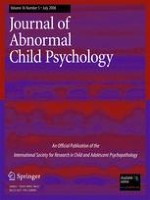01-07-2008
The Impact of Impairment Criteria on Rates of ADHD Diagnoses in Preschoolers
Gepubliceerd in: Research on Child and Adolescent Psychopathology | Uitgave 5/2008
Log in om toegang te krijgenAbstract
Behaviors characteristic of ADHD are common among preschool children, and as such, their clinical significance is oftentimes difficult to ascertain. Thus a focus on impairment is essential in determining the clinical significance of these behaviors. In order to explore the impact of impairment criteria on rates of diagnoses in inattentive/hyperactive children aged 36 through 60-months-old, we first developed, and psychometrically evaluated, the Children’s Problem Checklist (CPC) which was designed to assess psychosocial impairment associated with ADHD in a community sample of preschoolers (n = 394), and found its reliability and validity to be acceptable. We then examined the impact of the inclusion of various CPC-determined impairment criteria, over and above symptom criteria measured by the ADHD-RS-IV, using various cut points ranging from the 75th to 90th percentile of our community sample. This reduced the number of children meeting criteria for ADHD by 46–77%. These findings are discussed in terms of the importance of using impairment criteria, rather than just severity of inattention, impulsivity and hyperactivity, when diagnosing ADHD in preschool children.
